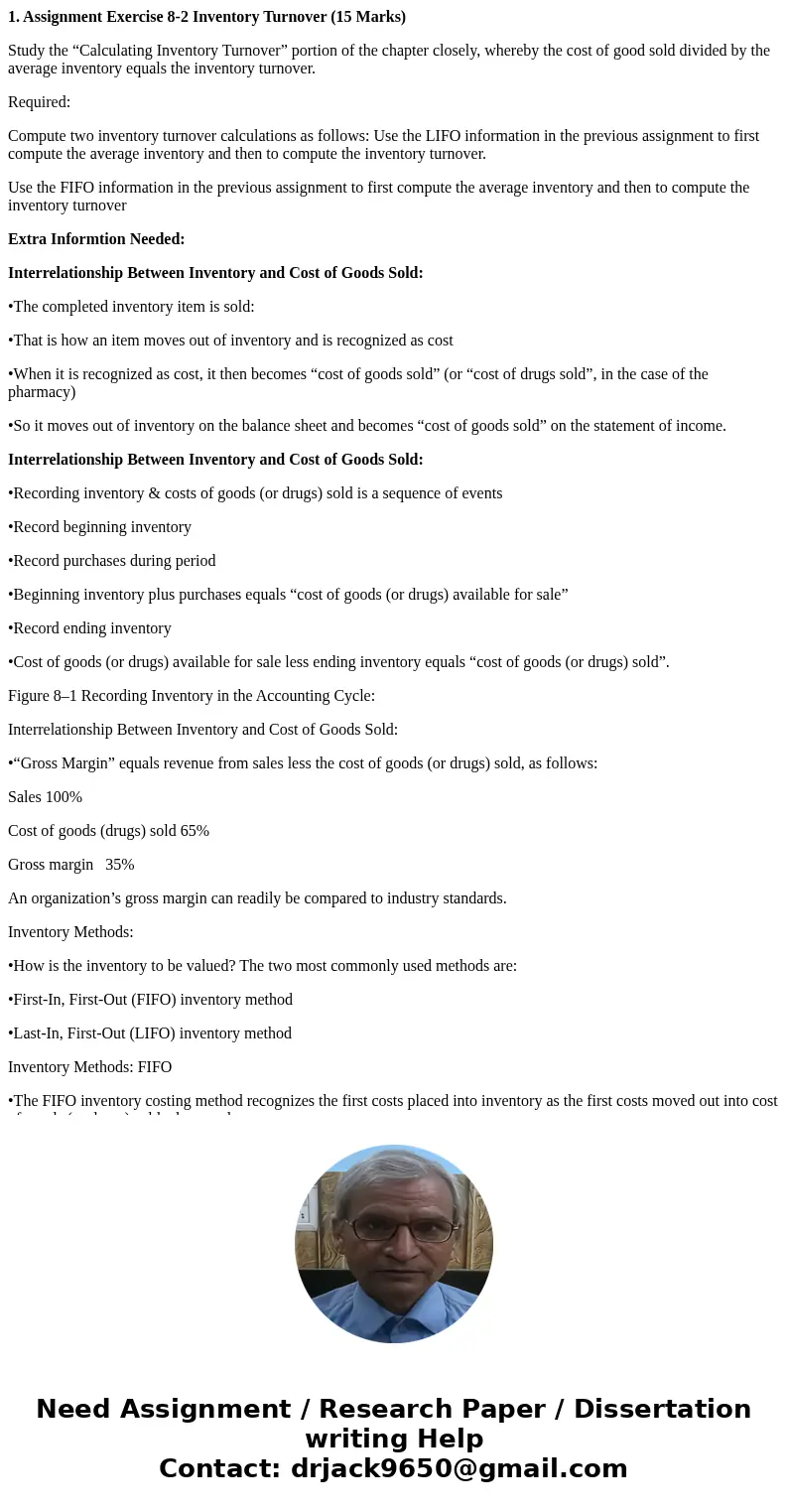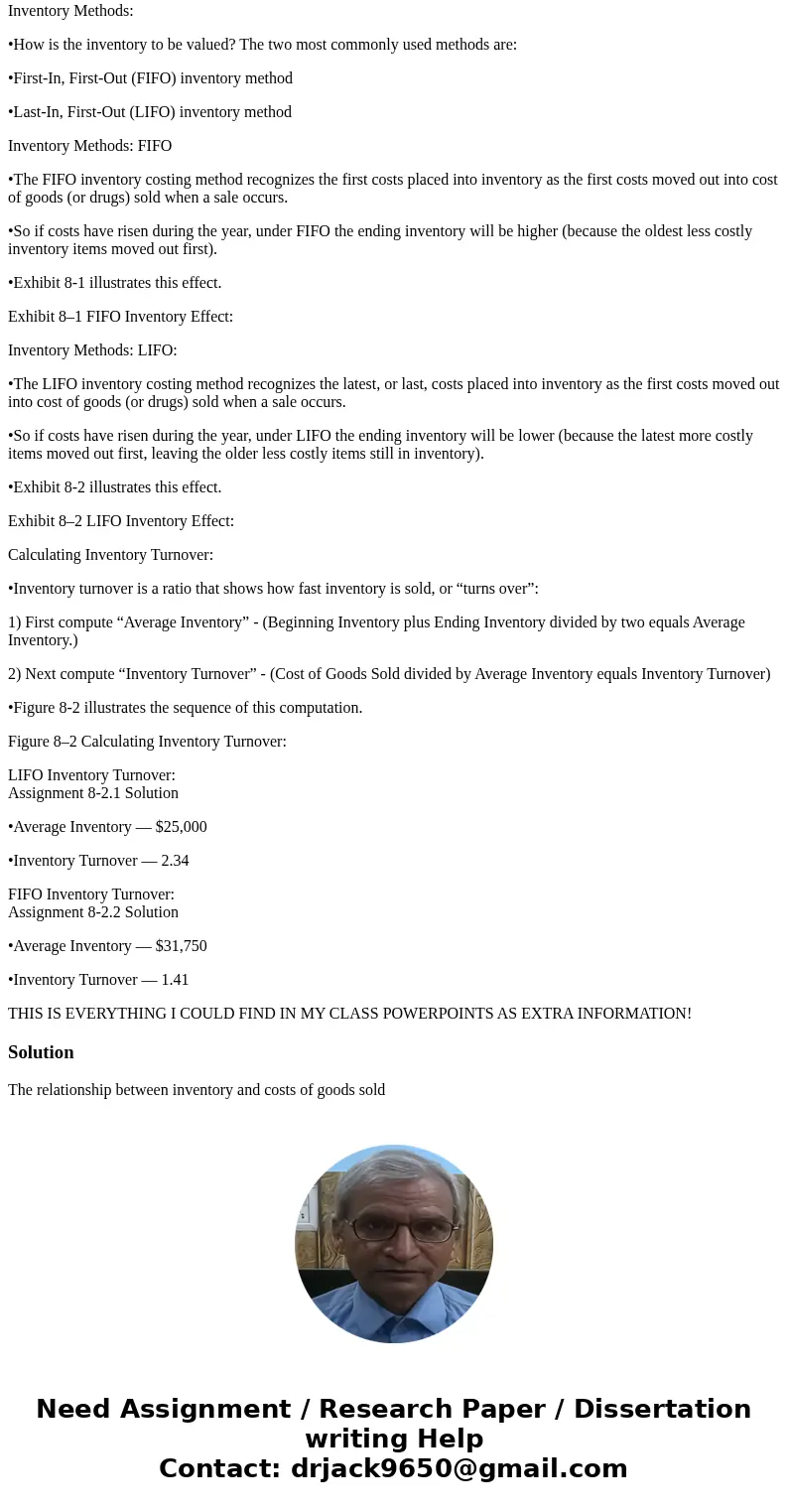1 Assignment Exercise 82 Inventory Turnover 15 Marks Study t
1. Assignment Exercise 8-2 Inventory Turnover (15 Marks)
Study the “Calculating Inventory Turnover” portion of the chapter closely, whereby the cost of good sold divided by the average inventory equals the inventory turnover.
Required:
Compute two inventory turnover calculations as follows: Use the LIFO information in the previous assignment to first compute the average inventory and then to compute the inventory turnover.
Use the FIFO information in the previous assignment to first compute the average inventory and then to compute the inventory turnover
Extra Informtion Needed:
Interrelationship Between Inventory and Cost of Goods Sold:
•The completed inventory item is sold:
•That is how an item moves out of inventory and is recognized as cost
•When it is recognized as cost, it then becomes “cost of goods sold” (or “cost of drugs sold”, in the case of the pharmacy)
•So it moves out of inventory on the balance sheet and becomes “cost of goods sold” on the statement of income.
Interrelationship Between Inventory and Cost of Goods Sold:
•Recording inventory & costs of goods (or drugs) sold is a sequence of events
•Record beginning inventory
•Record purchases during period
•Beginning inventory plus purchases equals “cost of goods (or drugs) available for sale”
•Record ending inventory
•Cost of goods (or drugs) available for sale less ending inventory equals “cost of goods (or drugs) sold”.
Figure 8–1 Recording Inventory in the Accounting Cycle:
Interrelationship Between Inventory and Cost of Goods Sold:
•“Gross Margin” equals revenue from sales less the cost of goods (or drugs) sold, as follows:
Sales 100%
Cost of goods (drugs) sold 65%
Gross margin 35%
An organization’s gross margin can readily be compared to industry standards.
Inventory Methods:
•How is the inventory to be valued? The two most commonly used methods are:
•First-In, First-Out (FIFO) inventory method
•Last-In, First-Out (LIFO) inventory method
Inventory Methods: FIFO
•The FIFO inventory costing method recognizes the first costs placed into inventory as the first costs moved out into cost of goods (or drugs) sold when a sale occurs.
•So if costs have risen during the year, under FIFO the ending inventory will be higher (because the oldest less costly inventory items moved out first).
•Exhibit 8-1 illustrates this effect.
Exhibit 8–1 FIFO Inventory Effect:
Inventory Methods: LIFO:
•The LIFO inventory costing method recognizes the latest, or last, costs placed into inventory as the first costs moved out into cost of goods (or drugs) sold when a sale occurs.
•So if costs have risen during the year, under LIFO the ending inventory will be lower (because the latest more costly items moved out first, leaving the older less costly items still in inventory).
•Exhibit 8-2 illustrates this effect.
Exhibit 8–2 LIFO Inventory Effect:
Calculating Inventory Turnover:
•Inventory turnover is a ratio that shows how fast inventory is sold, or “turns over”:
1) First compute “Average Inventory” - (Beginning Inventory plus Ending Inventory divided by two equals Average Inventory.)
2) Next compute “Inventory Turnover” - (Cost of Goods Sold divided by Average Inventory equals Inventory Turnover)
•Figure 8-2 illustrates the sequence of this computation.
Figure 8–2 Calculating Inventory Turnover:
LIFO Inventory Turnover:
Assignment 8-2.1 Solution
•Average Inventory — $25,000
•Inventory Turnover — 2.34
FIFO Inventory Turnover:
Assignment 8-2.2 Solution
•Average Inventory — $31,750
•Inventory Turnover — 1.41
THIS IS EVERYTHING I COULD FIND IN MY CLASS POWERPOINTS AS EXTRA INFORMATION!
Solution
The relationship between inventory and costs of goods sold


 Homework Sourse
Homework Sourse